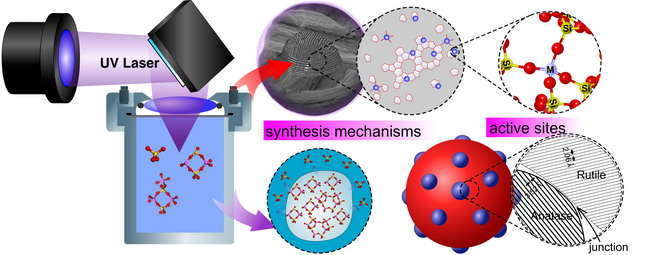我组受邀撰写的文章“UV Raman Spectroscopic Studies on Active Sites and Synthesis Mechanisms of Transition Metal-Containing Microporous and Mesoporous Materials”在近期出版的《Accounts of Chemical Research》上发表(Fengtao Fan,Zhaochi Feng, Can Li, Accounts of Chemical Research, 2009, ASAP http://pubs.acs.org/doi/pdfplus/10.1021/ar900210g)
文章报道了近几年来我组利用紫外拉曼光谱在含过渡金属杂原子分子筛(如TS-1, Ti-MCM-41,Fe-ZSM-5和Fe-SBA-15)活性位鉴定,以及几种典型分子筛(如X型分子筛,Fe-ZSM-5)合成机理研究方面取得的进展。
我组于1998年在李灿老师带领下成功研制出我国第一台具有自主知识产权的紫外拉曼光谱仪,解决了国际拉曼光谱领域长期存在的荧光干扰问题,并在国际上最早将其应用于催化及材料科学的研究。通过紫外共振拉曼光谱首次获得了钛硅分子筛(TS-1)中有关骨架钛物种存在的直接证据。建立了鉴定微孔和中孔分子筛骨架中过渡金属杂原子的拉曼光谱研究方法,这一方法已被国际催化界认为是一种最为可靠的杂原子表征方法。利用紫外拉曼避开荧光和增加灵敏度的特点,自行设计了可以原位研究水热合成过程的原位紫外拉曼光谱池,从分子层次上研究了杂原子分子筛合成中含杂原子活性中心的演化以及分子筛形成过程。
除了紫外拉曼光谱在分子筛催化剂相关领域的研究工作,我组还利用紫外拉曼光谱发现了氧化钛表面与体相结构不同且温度增加时相变不同步,并将氧化钛表面物相信息和光催化活性相关联,提出了“锐钛矿-金红石表面结增强光催化活性”的新概念;将紫外拉曼光谱应用到在负载型高分散过渡金属氧化物催化剂、催化剂表面积炭失活、固体氧化物超强酸、光电材料以及生物化学等多个研究领域。2004年研究组又研制成功紫外——可见全波段共振拉曼光谱议,使我国在拉曼光谱的催化表征研究方面继续处于国际先进水平。2008年,我组与卓立汉光仪器公司合作,开始将紫外拉曼光谱仪产业化。
在过去的10年间,紫外拉曼光谱已经在化学、物理和生命科学等诸多领域显示出巨大的优越性,成为一项重要的分子光谱技术。由于我组工作的影响,国内外许多研究机构纷纷与我所开展了紫外拉曼光谱在催化和材料科学方面的合作研究工作,同时国外厂商纷纷加紧紫外拉曼光谱仪的研制。紫外拉曼光谱技术及其在催化研究中的应用产生了重要的学术和社会影响。


UV Raman Spectroscopic Studies on Active Sites and Synthesis Mechanisms of Transition Metal-Containing Microporous and Mesoporous Materials
Fengtao Fan, Zhaochi Feng, Can Li
Acc. Chem. Res., Articles ASAP (As Soon As Publishable)
Publication Date (Web): December 22, 2009 (Article)
DOI: 10.1021/ar900210g
Abstract
Microporous and mesoporous materials are widely used as catalysts and catalyst supports. Although the incorporation of transition metal ions into the framework of these materials (by isomorphous substitution of Al and Si) is an effective means of creating novel catalytic activity, the characterization of the transition metal species within these materials is difficult. Both the low concentration of the highly dispersed transition metal and the coexistence of extraframework transition metal species present clear challenges. Moreover, the synthetic mechanisms that operate under the highly inhomogeneous conditions of hydrothermal synthesis are far from well understood.
A useful technique for addressing these challenges is UV Raman spectroscopy, which is a powerful technique for catalyst characterization and particularly for transition metal-containing microporous and mesoporous materials. Conventional Raman spectroscopy, using visible and IR wavelengths, often fails to provide the information needed for proper characterization as a result of fluorescence interference. But shifting the excitation source to the UV range addresses this difficulty: interference from fluorescence (which typically occurs at 300−700 nm or greater) is greatly diminished. Moreover, signal intensity is enhanced because Raman intensity is proportional to the fourth power of the scattered light frequency.
In this Account, we review recent advances in UV Raman spectroscopic characterization of (i) highly dispersed transition metal oxides on supports, (ii) transition metal ions in the framework of microporous and mesoporous materials, and (iii) the synthetic mechanisms involved in making microporous materials. By taking advantage of the strong UV resonance Raman effect, researchers have made tremendous progress in the identification of isolated transition metal ions incorporated in the framework of microporous and mesoporous materials such as TS-1, Ti-MCM-41, Fe-ZSM-5, and Fe-SBA-15. The synthetic mechanisms involved in creating microporous materials (such as Fe-ZSM-5 and zeolite X) have been investigated with resonance and in situ UV Raman spectroscopy. The precursors and intermediates evolved in the synthesis solution and gels can be sensitively detected and followed during the course of zeolite synthesis. This work has resulted in a greater understanding of the structure of transition metal-containing microporous and mesoporous materials, providing a basis for the rational design and synthesis of microporous and mesoporous catalysts.